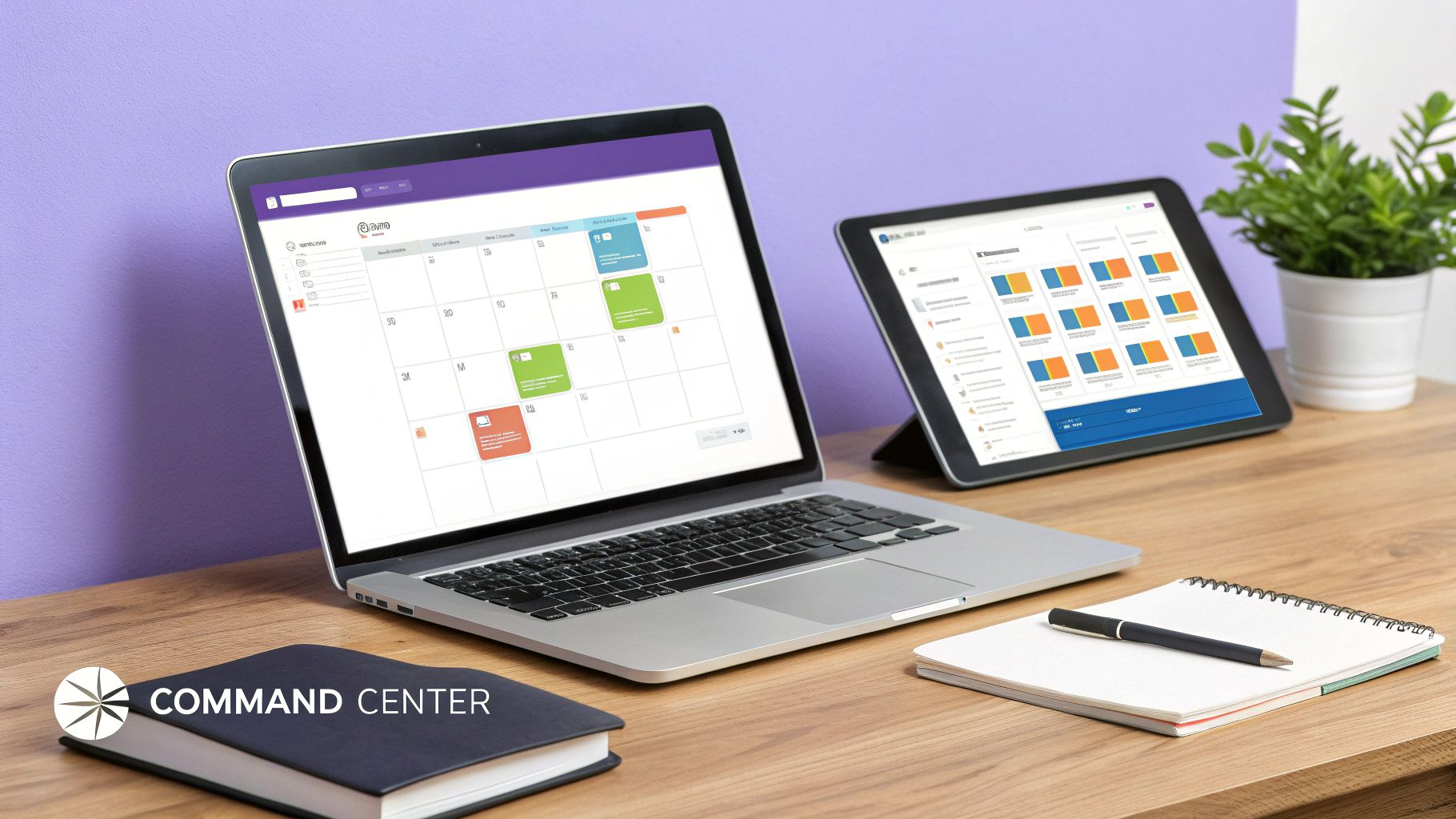If you've ever felt like you're juggling flaming torches while riding a unicycle, you know what it’s like to manage multiple social media accounts. It's a constant high-wire act where one wrong move can send everything tumbling down.
The goal is to turn that chaos into a structured, efficient workflow. This guide will give you actionable steps to schedule content in advance, maintain a consistent brand voice for each profile, and use the right tools to make it all happen seamlessly.
Why Managing Social Accounts Feels So Chaotic

Many brand managers and marketers know the daily grind all too well. You're constantly under pressure to keep each brand's voice distinct, all while trying to boost engagement across a half-dozen different channels. For example, the witty, meme-heavy tone for a DTC snack brand on TikTok is completely different from the professional, data-driven voice needed for a B2B software company on LinkedIn.
This isn't just about being busy; it's about the very real challenges baked into the job.
The Scale of the Challenge
The sheer number of people online is staggering. Experts predict there will be 5.41 billion social media users worldwide by 2025, with the average person hopping between six or seven platforms every month.
This massive audience is both a huge opportunity and a massive headache. Each platform has its own rules of engagement, audience expectations, and unique content formats. That constant demand for perfectly tailored content—a polished carousel for Instagram, a quick-fire video for TikTok, and an insightful article for LinkedIn—is a fast track to burnout.
For anyone just starting out, this actionable social media marketing guide is a fantastic resource for building a solid foundation.
Common Pain Points
Beyond just creating content, the logistical hurdles can be a nightmare. Here’s what managers are constantly up against:
- Security Risks: Logging in and out of a dozen accounts from the same device is a huge red flag for platforms. This often triggers security alerts and can get your profiles locked.
- Content Mix-Ups: We've all heard the horror stories. Accidentally posting a casual TikTok draft to a formal LinkedIn page is an easy—and incredibly embarrassing—mistake to make.
- Inconsistent Branding: Without a solid system in place, maintaining a unique and consistent tone of voice for each brand feels next to impossible. For example, a follower might see a fun, emoji-filled post one day and a corporate, jargon-heavy one the next, leading to brand confusion.
The real problem isn't the workload itself, but the lack of a system. When every task is reactive, chaos is inevitable. The key is building a proactive framework that brings order to your social media efforts.
Once you acknowledge these common struggles, you can start building a strategy to overcome them. The goal is to create a system that not only saves time and protects your accounts but also frees you up to focus on what really matters: creating great content that connects with your audience.
Build Your Social Media Command Center

If you're juggling multiple social media accounts, you know the chaos. Hopping between tabs, trying to remember what was posted where—it's a recipe for burnout and mistakes. The secret to taming this beast is to build a central hub, a single source of truth for all your social activities. Think of it as your mission control for planning, scheduling, and organizing everything.
Getting this set up starts with picking the right tools, but it’s not just about grabbing the most popular platform off the shelf. Your command center should be built around your workflow. The needs of a solo freelancer are worlds apart from an agency managing dozens of client profiles.
The way teams are structured varies wildly. It turns out nearly 40% of marketers fly solo on social media, while others are part of larger teams. Interestingly, while 44% of teams stick to one or two core tools, many use five or more, which just creates more fragmentation. This is exactly why a consolidated system is so critical.
Create a Unified Content Calendar
The absolute backbone of your command center is a unified content calendar. Forget scattered spreadsheets and last-minute scrambles. A good calendar gives you a bird's-eye view of everything planned across every single channel, making scheduling conflicts a thing of the past.
Here’s a practical example: imagine you’re managing accounts for a local coffee brand on Instagram, TikTok, and Facebook. Your calendar would show the "Tuesday Brew Tip" going live on Instagram, a behind-the-scenes video of a new roast on TikTok for Wednesday, and a promo for a weekend discount hitting Facebook on Friday. That visual timeline is what stops you from accidentally blasting the same exact content everywhere at once.
If you’re managing multiple accounts, finding the right tool to visualize this is key. Some platforms are great for solo creators, while others offer robust team features.
Choosing Your Social Media Management Tool
Finding the right platform can feel overwhelming, but focusing on features that simplify multi-account management is the way to go. Here’s a quick breakdown of some popular options to help you decide.
| Tool | Best For | Key Multi-Account Features | Starting Price |
|---|---|---|---|
| Sprout Social | Agencies & Large Teams | Unified inbox, team workflows, advanced reporting | $249/month |
| Hootsuite | All-in-One Management | Bulk scheduling, content library, social listening | $99/month |
| Later | Visual-First Platforms (IG, TikTok) | Visual planner, user-generated content tools | $18/month (for more features) |
| Buffer | Small Businesses & Solopreneurs | Simple scheduling, intuitive interface, content queues | Free plan available |
Ultimately, the best tool is the one that fits your budget and workflow. Don't be afraid to take advantage of free trials to see which one feels the most natural for you and your team.
A shared digital asset library is non-negotiable. This is simply a central folder—it could be Google Drive, Dropbox, or a feature built into your management tool—that holds every approved visual, logo, graphic, and video clip.
This one simple step prevents so many headaches down the road:
- Brand Consistency: Everyone on the team is pulling from the same source, using the correct high-resolution logos and brand colors. No more pixelated graphics.
- Efficiency: For example, instead of searching Slack for "that photo of the new product," you can go straight to the 'New Products Q3' folder and grab the approved images.
- Version Control: You can be sure that only the latest, approved assets are in circulation, keeping outdated visuals from accidentally popping up in a post.
A well-organized command center does more than just save time—it’s a system that proactively prevents errors. By centralizing your calendar and assets, you build a foundation for scalable, stress-free social media management.
Structure Your Approval Workflow
For teams, a clear approval process is what stands between you and a potentially embarrassing typo or off-brand post. It's a simple safety net that ensures every post gets a second look for accuracy, tone, and brand alignment before it goes live. To make it easy to direct your audience from all these different platforms to your key links, it's also smart to use one of the best link in bio tools.
For example, an agency could set up a simple two-step flow within their management tool: the junior content creator drafts the post and tags it as 'Needs Review.' The account manager then gets a notification, reviews the draft, and either approves it for scheduling or leaves comments for revision. This small checkpoint eliminates bottlenecks while keeping quality high. Part of a robust strategy also means having the right technical setup; our guide on proxies for social media breaks down how they fit into a secure and effective management system.
Master Your Content Creation Workflow

Consistency is the name of the game on social media, but let's be real—the constant pressure for new content is a one-way ticket to burnout. If you want to stay sane, you have to ditch the reactive, "what do I post today?" mindset. It's time to build a sustainable content engine.
The secret? Content batching. Instead of scrambling every morning, you set aside dedicated time—maybe a day or two each month—to get it all done at once. You plan it, create it, and schedule it. This simple shift doesn't just save you a ton of time; it also keeps your brand's voice and message consistent across every profile you manage.
For a practical example, a freelance social media manager might block off every other Friday to create two weeks' worth of content for all their clients. This turns a chaotic daily chore into a predictable, manageable system.
Embracing Smart Automation with AI
AI has quickly become an indispensable sidekick for social media managers, especially when it comes to brainstorming and drafting. In fact, more than three-quarters of social strategists are already using AI in their workflows, often for high-level planning rather than just cranking out posts. This is a huge shift, freeing up valuable brainpower for the creative work that actually matters. You can see more on these trends over at Hootsuite's research page.
For actionable insight, try using an AI tool with a prompt like, "Generate 5 Instagram post ideas for a vegan restaurant, focusing on a new summer menu. Include a call to action for reservations." Then, take those ideas and refine the captions to match the restaurant's unique, friendly voice. The trick is to treat AI as a creative partner, not a replacement. It has to sound human. This is also where a solid, integrated tool comes in handy, as some platforms allow for a smooth integration with other platforms to make your whole workflow more powerful.
The goal isn't to sound like a robot. It's to use technology to smash through creative blocks and scale your output. Think of AI as your junior copywriter—it gets the first draft done, but you bring the final polish.
Repurpose Content Like a Pro
Why reinvent the wheel for every single platform? That’s just inefficient. A much smarter move is to create one "pillar" piece of content—like a deep-dive blog post—and then slice and dice it for your other channels. This strategy gets your core message in front of more people while still respecting what works best on each platform.
This approach squeezes every last drop of value out of your hard work. By repurposing, you're reinforcing key messages across your entire digital footprint without sounding like a broken record.
Here’s a practical example of how one blog post, "5 Time-Saving Tips for Busy Professionals," can fuel an entire week of content:
- LinkedIn Article: Post a condensed, professional take on the blog, zeroing in on the key data and actionable tips that a business audience craves.
- Instagram Carousel: Design a slick carousel with 5-7 slides. Each slide should highlight one tip with a bold graphic and minimal text.
- Twitter Thread: Break down the 5 tips into a snappy 8-10 tweet thread. Use emojis and line breaks to make it easy to read, and finish with a link back to the full article.
- Facebook Post: Kick off a conversation by asking, "What's your #1 time-saving hack?" Pair it with an eye-catching graphic of the post's title and a link for anyone who wants to learn more.
Keep Your Accounts Secure and Active
Nothing craters your social media momentum faster than seeing that dreaded "your account has been locked" message. It’s a gut-wrenching moment, and it happens more often than you think when you're managing multiple accounts.
When you log into dozens of profiles from the same computer, using the same internet connection, platforms like Instagram and Facebook get jumpy. Their algorithms are built to sniff out and shut down anything that looks like bot activity. Unfortunately, multiple logins from a single IP address is a massive red flag, even if you’re a completely legitimate manager doing your job. This is one of the most common triggers that gets accounts flagged, frozen, or banned, often without any warning.
Why Platforms See You as a Risk
Social media platforms are in a constant war against spam, fake accounts, and automated bots. To them, seeing a dozen accounts being accessed from one location looks suspicious—it mimics the behavior of a bot farm.
When their automated systems detect this, it can lead to a few frustrating outcomes:
- Shadowbanning: Your content's reach gets throttled, and you won't even know it's happening.
- Verification Loops: You're constantly forced to solve captchas or verify accounts with a phone number, killing your productivity.
- Account Locks: You get temporarily or permanently locked out of a client's profile, leading to some very awkward conversations.
It's not personal; it's just their security systems doing what they were designed to do. To manage a roster of social media accounts without issues, you have to make each profile's activity look distinct and completely natural.
Give Each Profile a Unique Digital Fingerprint
So, how do you fix this? The most effective strategy is to give each account its own unique digital identity. This is exactly what proxies are for. A proxy acts as a middleman, assigning a different IP address to each social media profile you manage.
For instance, if you're a social media manager in New York, you can use a residential proxy from a provider like IPFLY to make it look like you're logging into a client's account from their home city of Chicago. For another client based in California, you can use a mobile proxy that shows a login from Los Angeles. This makes every login look like a normal user accessing their own account from a believable location.
Using proxies is like giving each of your client accounts its own separate, legitimate home on the internet. It’s the single most powerful step you can take to stop platforms from flagging your management activity as a threat.
This one change makes your entire workflow appear organic and drastically cuts down the risk of getting flagged.
Essential Security Habits You Cannot Ignore
Beyond proxies, some foundational security habits are simply non-negotiable. These practices protect both you and your clients from hackers, unauthorized access, and potential disasters. Think of this as your daily security checklist.
-
Use a Password Manager: Juggling dozens of complex passwords in a spreadsheet is asking for trouble. Get a tool like 1Password or LastPass. They generate and store rock-solid passwords for every account, all secured behind one master password you have to remember.
-
Enable Two-Factor Authentication (2FA): This is your most critical safety net. 2FA adds a second verification step—usually a code sent to a phone—before granting access. Even if a password gets stolen, the thief can't get in without the physical device. You should have 2FA enabled on every single account you manage. No exceptions.
-
Conduct Regular Security Audits: At least once a quarter, take a few minutes to review who has access to your accounts and management tools. Remove old team members, revoke access for past contractors, and double-check that current staff have the right permission levels. This simple habit prevents forgotten backdoors from becoming future security nightmares.
Track Performance Without Drowning in Data

Getting your content out there is only half the job. If you aren't tracking what works—and what doesn't—you're just flying blind. You end up wasting time and effort on strategies that simply don't deliver. The real key to winning is to monitor all your channels efficiently, without getting lost in a sea of confusing numbers.
A true game-changer for anyone juggling multiple accounts is the unified inbox. Imagine all your Instagram DMs, Facebook comments, and LinkedIn messages funneling into one single, manageable feed. No more frantic tab-switching. It transforms community management from a chaotic chore into a streamlined process. According to McKinsey, a staggering 40% of customers expect a reply within an hour, and honestly, a unified inbox is the only practical way to hit that mark when you're managing more than one profile.
Focus on Metrics That Actually Matter
It’s way too easy to get distracted by vanity metrics. Sure, a high follower count or a flood of likes feels good, but those numbers rarely translate into actual business success. To really understand your performance, you need to zero in on the key performance indicators (KPIs) that signal real growth.
Instead of just counting likes, start tracking these more meaningful metrics:
- Engagement Rate: This is the percentage of your audience that's actually interacting with your content—think comments, shares, and saves. It’s a far better indicator of content quality than just raw likes.
- Click-Through Rate (CTR): This tells you how many people are clicking the links in your posts. A healthy CTR means your content is compelling enough to drive action, which is exactly what you want.
- Conversion Rate: This is the ultimate bottom-line metric. It tracks how many people completed a desired action, like buying a product or signing up for a newsletter, after coming from your social media.
Focusing on these KPIs gives you a much sharper picture of what's driving results. For an even deeper dive, our guide on leveraging data scraping for insights explains how to collect and analyze this kind of information to sharpen your strategy.
Don't let your reporting become a data dump. The whole point is to find actionable insights—the "so what?" behind the numbers—that you can immediately use to make your content better.
Set Up Simple Automated Reports
You shouldn’t have to spend hours every week pulling numbers and plugging them into a spreadsheet by hand. It's a massive time sink. Thankfully, most social media management tools let you build and automate custom reports that land right in your inbox.
Set up a simple weekly or monthly report that highlights your core KPIs for each account. This lets you spot trends, see how platforms are performing against each other, and make quick, data-driven decisions. For instance, if you notice your Instagram Reels have a fantastic engagement rate but a low CTR, you know it's time to test different calls-to-action in your captions. An actionable change would be to move from "Link in bio" to a more direct "Tap our link in bio to shop this look!"
This automated approach frees you from tedious data collection so you can spend more time on what truly matters: actually refining your strategy based on what the numbers are telling you.
Got Questions? We’ve Got Answers.
Juggling a bunch of social media accounts always stirs up a few questions. Here are some of the most common hurdles managers run into, along with some straightforward answers to help you lock down your strategy.
What's the Best Tool for Managing 10+ Social Media Accounts?
Once you’re managing 10 or more accounts, you’ve officially graduated to enterprise-level tools. Think platforms like Sprout Social or Agorapulse. These are built from the ground up to handle serious volume, offering must-have features like unified inboxes, deep analytics, and collaboration workflows for teams.
But "best" is subjective—it all comes down to what you really need. Sprout Social is a powerhouse for in-depth analytics and reporting, perfect if you're obsessed with data. On the other hand, Agorapulse often gets top marks for its incredible inbox management and engagement tools.
If you're watching your budget, a tool like Buffer is a fantastic option. It offers scalable plans that can grow with you without that hefty enterprise price tag.
How Do I Keep a Unique Brand Voice for Each Account?
The secret to keeping brand voices distinct is creating a simple, one-page brand style guide for every account you manage. Seriously, it doesn't need to be a massive document. Just a quick-reference sheet is enough.
Your mini-guide should nail down a few key things:
- Tone of Voice: Is the brand witty and sarcastic? Professional and authoritative? Casual and friendly?
- Messaging Pillars: What are the top 3-5 core topics the brand always talks about? For a fitness brand, this might be "Workout Tips," "Healthy Recipes," and "Member Spotlights."
- Words to Use/Avoid: Make a list of brand-specific jargon and phrases, along with any words that are completely off-limits. A tech startup might use "synergy," while a coffee shop would avoid it at all costs.
- Emoji Strategy: Which emojis fit the brand's personality (e.g., ☕️✨ for the coffee shop) and which ones should never be used (e.g., 💼 for a playful brand)?
Before you sit down to batch-create content, just give that brand's guide a quick scan. It’s a simple gut check that stops all your accounts from sounding exactly the same.
Creating these mini-guides is a small upfront investment that pays off enormously in brand consistency. It’s your single source of truth that ensures anyone on your team can capture the right voice, every time.
Is It Safe to Use One Tool to Manage All My Accounts?
Yes, for the most part, it's safe to use a single tool—if you're using a reputable social media management platform and sticking to security best practices. The big names in the industry use official platform APIs and have their own robust security measures to keep your data safe.
But you should absolutely add your own layers of protection. Always enable two-factor authentication (2FA) on both your management tool and on every single social account connected to it. No exceptions.
For agencies or anyone managing client profiles, a proxy service is non-negotiable. It prevents platforms from seeing dozens of logins from a single IP address and flagging them as suspicious activity. This one move drastically lowers the risk of getting accounts locked or, even worse, banned.
Managing multiple accounts securely and efficiently is the bedrock of growth. IPFLY delivers the high-quality residential and mobile proxies you need to give each account its own unique digital fingerprint, keeping your operations seamless and secure.
Explore our solutions at https://www.ipfly.net/.


